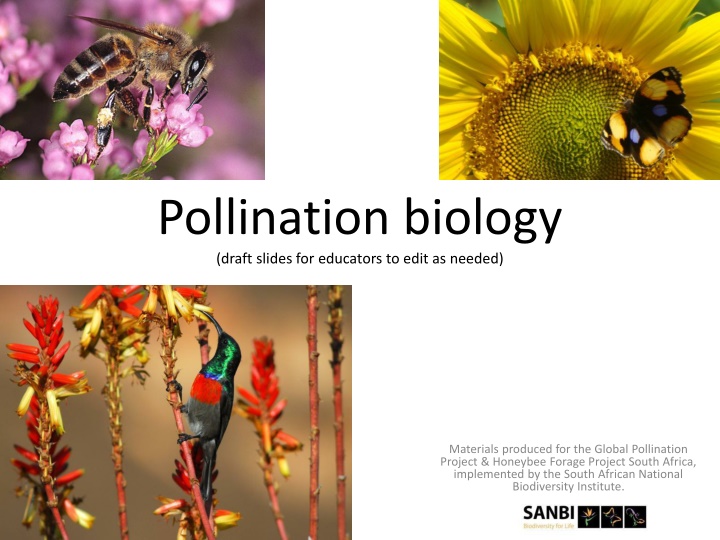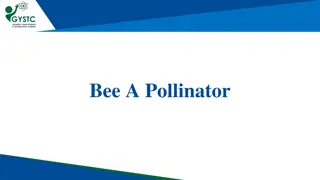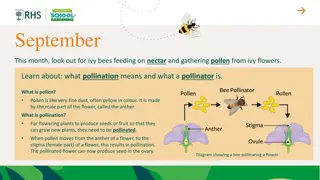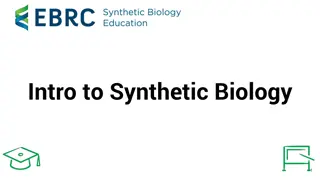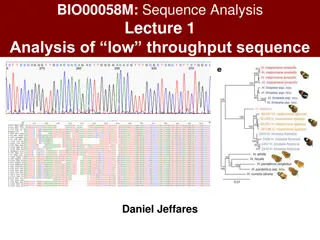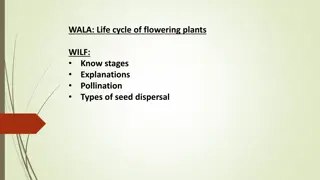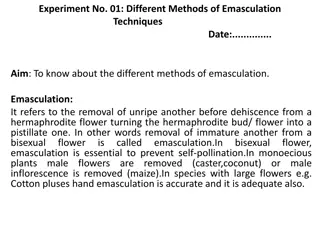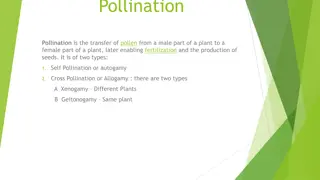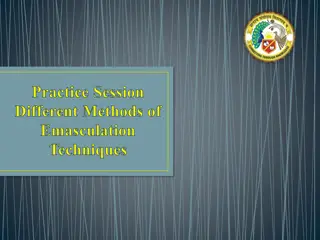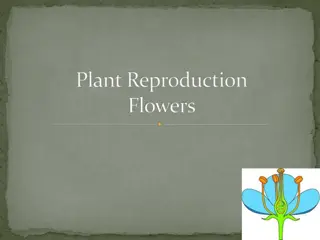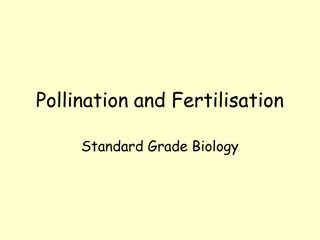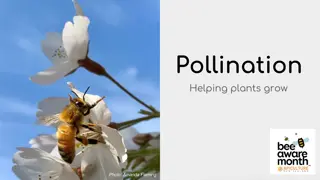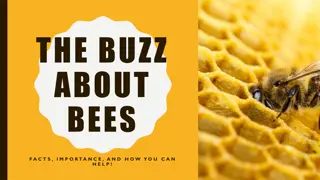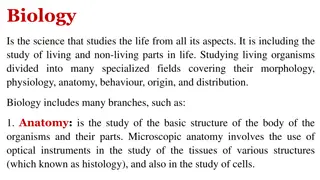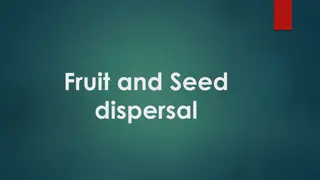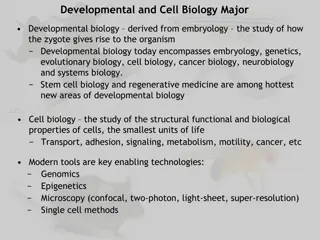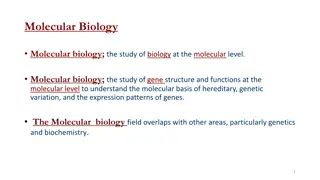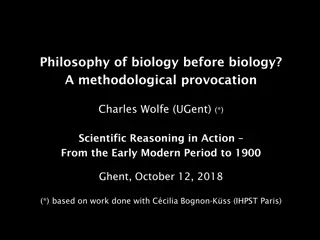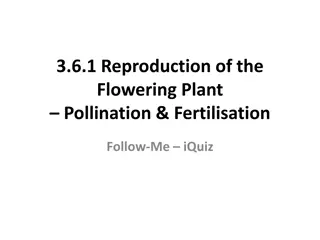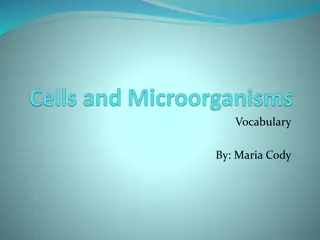Pollination Biology and the Importance of Honeybees
Pollination is a crucial process for plant reproduction, with both abiotic and biotic methods. Self- and cross-pollination play essential roles, relying on various agents like insects. Honeybees, vital pollinators, have a significant impact on food production and ecosystem balance, demonstrating their ecological and human value through pollination services.
Download Presentation

Please find below an Image/Link to download the presentation.
The content on the website is provided AS IS for your information and personal use only. It may not be sold, licensed, or shared on other websites without obtaining consent from the author.If you encounter any issues during the download, it is possible that the publisher has removed the file from their server.
You are allowed to download the files provided on this website for personal or commercial use, subject to the condition that they are used lawfully. All files are the property of their respective owners.
The content on the website is provided AS IS for your information and personal use only. It may not be sold, licensed, or shared on other websites without obtaining consent from the author.
E N D
Presentation Transcript
Pollination biology (draft slides for educators to edit as needed) Materials produced for the Global Pollination Project & Honeybee Forage Project South Africa, implemented by the South African National Biodiversity Institute.
Pollination is the process by which pollen is transferred in the reproduction of plants, thereby enabling fertilisation and the production of fruit and seeds (sexual reproduction). Abiotic pollination: pollination without the involvement of other living organisms (e.g. wind or water). Only 10% of flowering plants are pollinated without animal assistance. Biotic pollination: pollination by a pollinator (insects are the most important pollinating animals, but birds, bats and rodents are also pollinators of some plants).
Self- & cross-pollination CROSS-POLLINATION: the transfer of pollen from an anther of the flower of one plant to a stigma of the flower of another plant. SELF-POLLINATION: fertilisation by transfer of pollen from the anthers of a flower to the stigma of the same flower (autogamy) or to the stigma of n another flower on the same plant (geitonogamy) Self: no exchange of genetic material Cross: exchange of genetic material
Agents of pollination Cross-pollination depends on insects visiting flowers of the same species in sequence. To help ensure that this happens, the plants have various characteristics that help pollinators locate the right flowers, including the colour, size, shape and scent of the flowers, as well as the food reward. Sunbird: tubular, colourful flowers Honeybee: many varied flower types Beetles: flat or cup- shaped (big) flowers
Importance of honeybees & their relationship to our food (draft slides for educators to edit as needed) Materials produced for the Global Pollination Project & Honeybee Forage Project South Africa, implemented by the South African National Biodiversity Institute.
ECOLOGICAL VALUE OF POLLINATION - Valuable in their own right - Part of ecology HUMAN VALUE OF POLLINATION - Crops for human food + animal fodder - Fibres, wood and other materials - Plant breeding & flowers - Medicines - Aesthetic value
Pollinators and our food Insect pollination is essential for 35% of global food production. You can thank an insect pollinator for 1 out of every 3 bites of food you eat! Insects pollinate the flowers of the fruit and vegetable plants we rely on for a healthy and balanced diet (apples, melons, pumpkin, avo s, etc) while most of the staple food plants can self- pollinate or are wind-pollinated (like maize and wheat), or reproduce vegetatively (like potatoes). A world without insect pollinators would mean a world of far fewer food choices, more expensive food, and vastly different agriculture.
Honeybees Many commercial pollinator-dependent crops are reliant on the honeybee as their pollinator. For most South African crops, honeybees are the most economically valuable pollinators because they are: - Very effective pollinators. - Indigenous (i.e. they are naturally found here). - They can be managed in the huge numbers needed to supply the pollination service to our large-scale commercial crops. Beekeepers supply the pollination service to growers/farmers, as well as harvest the honey from the bees to bottle and sell.
Honeybees in South Africa Two sub-species: Apis mellifera capensis and A.m. scutellata. Both good pollinators, especially if handled correctly. Wild & managed populations are the same, as they are indigenous honeybees; and because beekeepers trap swarms and sometimes managed bees swarm off into the wild. Eucalyptus flowers probably responsible for >60% of honey production in South Africa. Some beekeepers migrate 2 500km/yr following honey flows. 87% of colonies in W. Cape used for commercial pollination (~60k hives). New threats: Varroa mite, AFB, pesticides, forage limits, theft SA honeybees populations may not be as healthy as we believe.
Whats for dinner? Examples of parts of the plant we eat: Flowers: broccoli, cauliflower. Fruit: apple, peach, tomato, cucumber, pumpkin, avocado, watermelon, bean. Stems: sugar!, asparagus, celery, potatoes (modified stem). Leaves: lettuce, cabbage, tea, Brussels sprouts. Roots: carrot, sweet potato, radish. Seeds: nuts, maize/corn, peas, rice.
Know your veg pollination! Pollination requirements of vegetables can be discussed according to what part of the plant is eaten: If the vegetable is a fruit then pollination is required both for the production of the vegetable AND for seed production; e.g. tomatoes, peppers, eggplant, peas, beans, pumpkins, marrows, butternut, cucumbers, etc. If the vegetable is in the form of leaves or shoots (e.g. lettuce, cabbage, kohlrabi, broccoli, Brussels sprouts, spinach, Swiss Chard, leeks, onions, etc.) or is a storage root (e.g. carrots, beetroot, turnip, parsnip, etc.) then pollination is not required or desired for the production of the vegetable, but ONLY for seed production. If the vegetable is a storage stem then pollination is not required for EITHER the production of the vegetable or seed because seed is not required for propagation; e.g. potatoes, Jerusalem artichokes.
Chemical misuse Threats to honeybees & what we can do (draft slides for educators to edit as needed) Materials produced for the Global Pollination Project & Honeybee Forage Project South Africa, implemented by the South African National Biodiversity Institute. American Foulbrood Varroa mite on honeybee larva
Stress on honeybee health in SA Pests and diseases (American Foulbrood, Varroa mite). Chemicals such as pesticides. Global change factors (e.g. land use change & climate change). Over-working during the pollination season (being moved large distances in short timeframes). Scarcity of good forage resources. (the focus of SANBI project and therefore the focus of the rest of this PowerPoint) Many of the stresses that affect honeybees also impact other wild insect pollinators, and therefore any efforts we make at protecting the honeybee should help protect our wild insect pollinators.
Scarcity of good forage resources Land use changes (such as urbanisation or deforestation) may lead to habitat degradation and destruction. Intensified agriculture and forestry practices contribute to: loss of surrounding natural vegetation (monocultures). planting of nutrient-poor crops and non-flowering cultivars. Removal of good forage resources, such as some Eucalyptus some indigenous species.
Illustration of forage provision to managed honeybees in the Western Cape as an example of the diversity of forage used during the year canola apples Weeds (e.g. ramenas) eucalyptus Nov-Dec eucalyptus eucalyptus Jan-Feb Apr - June Jul-Aug Sep-Oct pears Fynbos citrus fynbos Some pollination- dependent crops are not good forage for honeybees, and provide only variable nutrition. Build-up & Swarm trapping Fynbos honey / maintenance Pollination season Honey
What we can do The planting of honeybee-friendly plants can help the issue of the scarcity of forage resources. Campaign for the planting of honeybee-friendly plants in your neighbourhood (e.g. city parks, in gardens, along road verges). Never kill honeybees or other pollinators with chemicals. Find out about the fruit and vegetables that you buy (are they in season, have chemicals been applied correctly and in a bee-friendly manner?). Become a researcher or help researchers. Much research is still needed, e.g. the impacts of climate change; pollination research; hive strength; etc.
